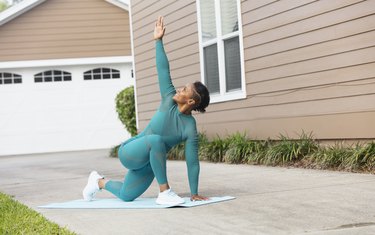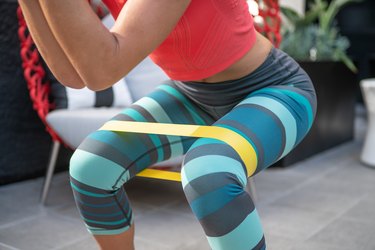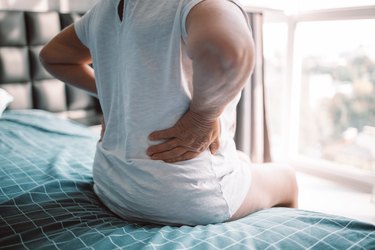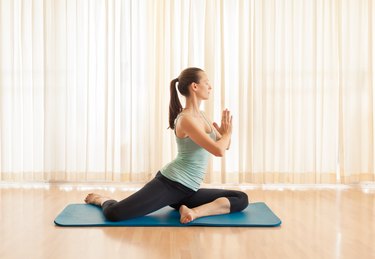
Got five minutes? You can feel better, reduce your chance of injury, decrease pain and even improve mental health outcomes in the long run — all with a little mobility work.
Improving your range of motion has all kinds of benefits besides touching your toes: An August 2017 study in PLOS One found for people aged 50 to 60, gaining mobility improved their ability to do day-to-day activities and boosted outcomes related to anxiety and depression.
Video of the Day
Young people benefit, too: A May 2021 study published in PeerJ found that, over six months, low-quality mobility increased the risk of injury sevenfold among people aged 22 to 24.
There's another benefit mobility work gives you right away: It feels good!
But that's only if you do it — and many of us don't. In one meta-analysis of studies on mobility and warm-up work published in February 2016 in Sports Medicine, scientists found that fewer than 50 percent of study participants were "highly compliant" with their mobility training regimens.
One common excuse is that it takes too long. Let's fix that: These five moves from top trainers can help you build and maintain the mobility you need to move well in just a few minutes per day. Choose one, two or all of them, and start feeling great.
1. The World’s Greatest Stretch
Just as compound exercises can work multiple muscles at once, compound mobility moves can help you move and mobilize lots of joints and muscles at the same time. And it doesn't get much more compound than a runner's lunge with a torso twist, commonly called the "world's greatest stretch" (WGS).
"It works so many muscles in one simple move. Specifically, it helps to engage the mobility of the spine, as well as your core and hips before working out," Richard Biglia, CPT, a trainer for iFit and NordicTrack, says. "Doing this can expand and mobilize your body before running, cycling or strength training and helps your body feel ready to go."
Because the move is dynamic, moving through ranges of motion instead of stretching and holding, it's ideal for preparing for physical activity, Jarrod Nobbe, CSCS, the head weightlifting coach for the Athletic Lab Weightlifting team, tells LIVESTRONG.com. It can also warm the body up by increasing heart rate, he says, making it a great way to wake up.
"Each morning, I perform rounds of this mobility flow for a full body effect, jokingly referring to it as my 'morning coffee,'" he says. "Participating in a mobility routine first thing in the morning allows the body to mobilize, increases core temperature, and decreases morning muscle tension. Often, you may even begin noticing increases in your daily energy and focus."
For Latreal Mitchell, CPT, an NASM certified personal trainer and owner of "No Excuses for Life" training, the WGS is her go-to move before exercise.
"It replicates many of the body's actions during exercise, making it an excellent intro to physical activity," she says. The move also increases circulation and lubricates the joints. "This can enhance overall performance, reduce the risk of injury, and improve the body's readiness for more intense movements."
Whether you choose to do the WGS when you wake up or before your next workout, aim for 1 to 3 sets of 5 to 10 stretches on each side, our experts say.
How to Do the World's Greatest Stretch
- Begin in a classic high plank position, with your hands under your shoulders and your body forming a straight line from head to heels.
- Step your right foot forward and place it next to your right hand. Your right knee should be bent at a 90-degree angle.
- Plant your left hand on the ground for support. Twist your upper body to the right, extending your right arm toward the sky so that your upper body forms a “T” shape. Follow your hand with your eyes to enhance the twist. You should feel a gentle stretch in your chest, back, hip flexors and hamstrings.
- Bring your right hand back to the ground, and step your right foot back to return to the high plank position.
- Repeat the lunge and twist sequence on the left side by stepping your left foot forward and twisting your upper body to the left.
Tip
If this is too hard, Mitchell says, try placing the back knee on the ground in the lunge position. And if the twist is too extreme, she says, “instead of reaching the arm toward the sky, beginners can keep the hand on the hip or gently rest it on the thigh.”
2. Cat-Cow Stretch
These two paired yoga moves help to mobilize the spine, hips and lats before a workout (or any time), Morit Summers, a NASM certified personal trainer, says. These three areas can be tight, especially if you sit a lot.
And it doesn't take many of these on-all-fours moves to feel relief and get things moving: "I tell people that even if they do 1 set of 5 cat-cows a day, that's a good thing," Summers says. She tends to do a few more: 1 to 2 sets of 5 to 10 reps.
Youll start on all fours. In the "cat" position, the spine is rounded and hips are tucked underneath the body. The "cow" position involves pushing the belly button down towards the ground to create a "U" shape in the back, with the hips sticking up and back behind you.
One key, Summers says, is breathing: When moving into cow, you should be inhaling. As you move into cat, you should be exhaling.
How to Do Cat-Cow
- Begin on your hands and knees, with your wrists directly beneath your shoulders, your knees directly beneath your hips. Inhale.
- As you exhale, round your spine up towards the ceiling and pull your belly button towards your spine. Tuck your chin to your chest. Concentrated on pressing away from the floor and round not just your hips, but also pull your hips underneath your body. This is the cat posture.
- As you inhale again, arch your back, letting your belly hang below you as you press your belly button toward the floor. Lift your tailbone and your head toward the ceiling, concentrating on pulling your chest toward the sky and pulling your shoulders way from your ears. This is the cow posture.
- Continue back and forth between the cat and cow posture.
3. Psoas Quad Stretch
"The hip joints act as a sort of engine for the body to move through space," Ryan Koziol, owner of RYKO Fitness, says. "If your hips are tight or imbalanced, this can make many activities and normal functions difficult or downright painful: think walking, putting on your shoes, or even sitting."
One hip flexor that can tighten, Koziol says, is the psoas major, a muscle that connects your upper and lower body. When it tightens up (especially due to sitting all day) it can cause postural issues that cascade into weak muscle groups all around the hips, including your abs, glutes, hamstrings and quadriceps.
To fight the tightness, Koziol suggests performing a psoas quad stretch, a move that uses a wall, bench, or couch. This move, he says, balances the pelvis into its proper neutral position, and can help relieve low back pain and hip tightness over time. To get these benefits, aim for 1 to 2 sets of 1 to 2 minutes on each side during the day.
The stretch should feel like a 7 out of 10 on intensity. If it's too intense, move your body and front leg farther from the bench.
How to Do the Psoas Quad Stretch
- Begin in a standing position in front of a couch or an adjustable bench set to a 90-degree incline (or lower if you have super tight hip flexors). Place the top of your right foot onto the bench behind you.
- Lower your right knee to the ground. Your shin should be flush to the bench and your knee should be positioned directly below your foot, or slightly in front if you're really tight. Your opposite leg should be positioned forward with a slight bend in the knee.
- To ensure your pelvis is neutral, or to cue a posterior tilt, think about “tucking your butt” under your torso.
- Hold this stretch for 1 minute to passively stretch the psoas and rectus femoris. If performing the move before a workout, do the hold for 20 to 30 seconds.
- Repeat on the other side, stretching on each side 1 to 2 times.
3. Hip 90-90 Rotation
Most of our daily activities keep us moving in a straight line forward and backward, and most of the exercises we do in the gym (like running, bench presses and squats) do the same. But rotating our hips regularly can reduce both back and knee pain, Greg Pignataro, CSCS, owner of Never Past Your Prime, says.
"Rotational movement tends to be excellent for joint health, because it activates proprioceptors that the brain relies on to determine which movements are and aren't safe," he says.
To incorporate some hip rotation, Pignataro suggests 1 to 2 daily sets of 20 hip 90-90 rotations. This seated move makes it easy to get these benefits in just a few minutes right after waking up, or during a long break from sitting.
How to Do Hip 90-90 Rotations
- Sit on the floor with your hands behind you for support. Place your left leg on the ground so that your thigh extends out to your left side, the outside of your leg is on the floor, and your knee is bent 90 degrees. The outside of your left thigh, knee, shin and foot will all be on the floor in this position.
- Extend your right thigh in front of you so that the inside of your thigh faces the floor, and your knee is bent 90 degrees. The inside of your right knee, calf and foot will be on the floor. This is the starting position.
- Keep your feet touching the floor and your knees bent 90 degrees as you rotate both your hips to the right so that your legs switch positions: Your right thigh will now be out to your right, with the outside parts of the leg on the floor. Your left thigh will now be in front of you, with the inside parts of your left leg on the floor.
- Rotate back to the starting position. Rotate back and forth in this way 20 times.
4. Thoracic Spine Extension
If there's one part of the body that everyone should mobilize, the answer is simple, says Mike Boyle, co-founder of Mike Boyle Strength and Conditioning in Massachusetts, and a former strength coach for the Boston Red Sox, Boston Bruins and Olympic ice hockey teams: "T spine, t spine, t spine."
"T spine" is your thoracic spine: The central part of your back between your lower back (or lumbar spine) and your upper back and neck (or cervical spine). When the thoracic spine is immobile, your body compensates by putting pressure on the other parts of your spine, Boyle says. This can lead to twisting and straining in the low back and neck, and both can lead to pain.
"One of the worst changes you can have is that hunchback and forward head. And that's being magnified in our [modern] situation by computers and phones," he says. These devices cause us to lean forward, shortening the muscles in the front of our bodies and lengthening those in the back.
To combat it, Boyle performs a simple thoracic extension every day on a foam roller.
"I'll almost lay there like a snow angel," he says. "I want to lengthen my pecs, lengthen my neck flexors, and increase my thoracic extension."
How to Do It a Thoracic Spine Extension
- Lie face up on the ground with your knees bent and feet flat on the floor with a foam roller under your mid-back, perpendicular to your spine.
- Lie back and open your chest, letting your head fall toward the floor behind you and your arms fall toward the floor to your sides. Feel your chest and neck opening.
- Stay like this for 30 to 60 seconds, or as long as feels good.


